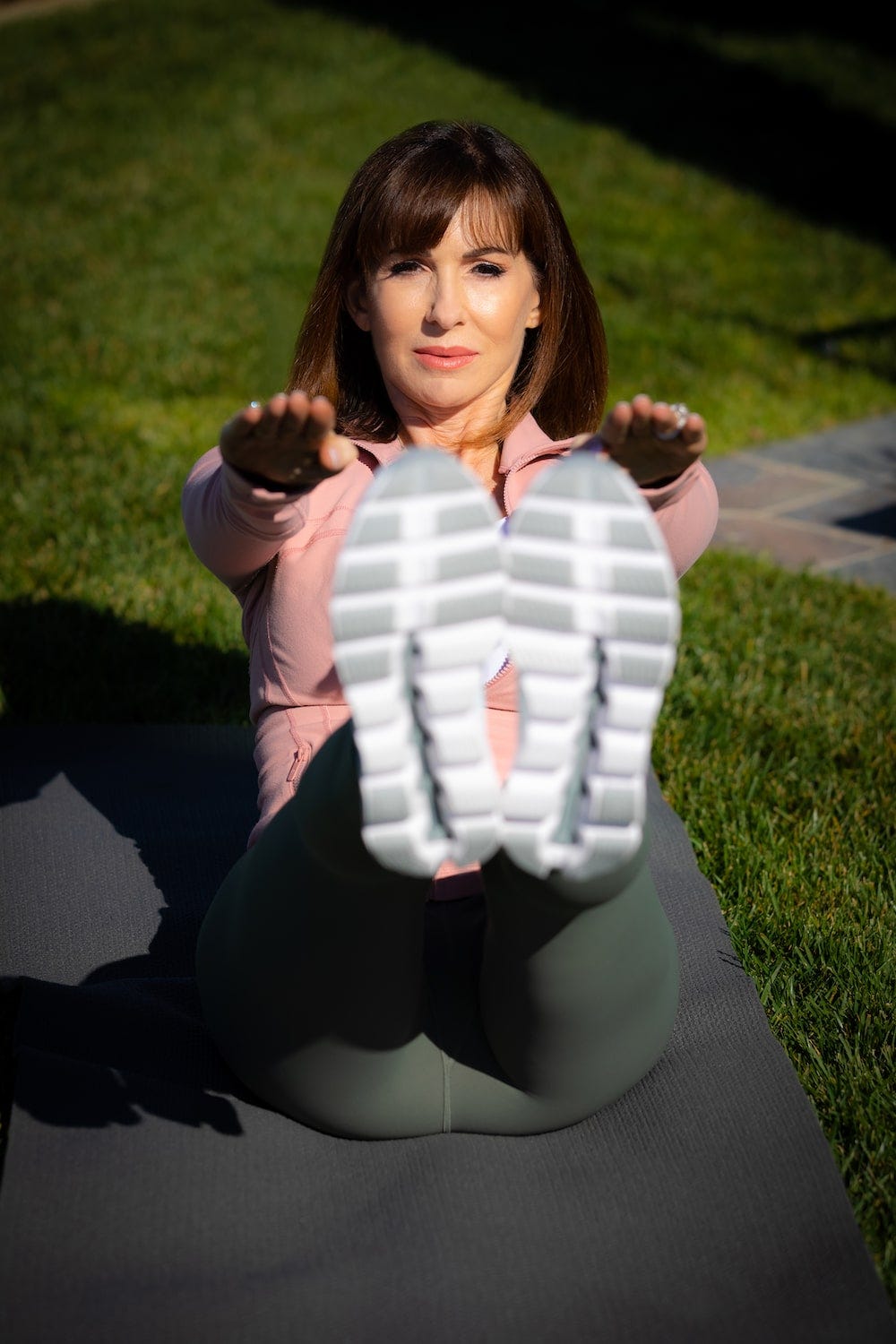Tana Amen’s Favorite Workout Routines for Women
In our age of modern conveniences and office jobs, Americans are more likely to have sedentary lifestyles, so physical activity has evolved from something we naturally do each day to something we must make an effort to prioritize. And for women—who are often juggling so many tasks, from child care to full-time jobs—it’s especially important to take care of ourselves first, so that we can be our best for everything else demanding our attention. In addition to eating a healthy diet, exercise is the answer for maintaining optimal health, both physical and mental.
Benefits of Workouts for Women
Some women initially want to work out so they can look better—and, yes, that’s a definite benefit. Feeling sexier, building muscle to create a more compact and toned appearance, and losing weight are all possible side effects of maintaining a regular exercise routine. But there are so many additional benefits when it comes to your overall health and longevity.
In the short term, exercise gives you a major energy boost. When I get up early and start my day with a challenging workout, I get an energy blast that’s better than any cup of coffee. Plus, I feel mentally clearer. I’m ready to tackle my day (and make healthier choices throughout). If you prefer night workouts, no problem—they’re great for de-stressing after the workday and encouraging sound sleep. Choose whatever works best for you; just be consistent and enjoy movement every day in some form.
In the long term, you’ll build up more resistance to serious illnesses, like diabetes, heart disease, and cancer, thanks to exercise’s many effects: lowering inflammation and cortisol (the stress hormone) throughout the body; generating feel-good chemicals like endorphins; better insulin sensitivity and oxygenation in the body’s cells; boosted metabolism; and much more. One study has even shown that middle-aged women with high levels of cardiovascular fitness were almost 90 percent less likely to develop dementia in their older years, compared to women with lower fitness levels.
One final note: The benefits of exercise persist long after the workout itself. Some people might think that working out revolves around burning calories, but this can be misleading. The actual calories burned in a given workout, like running on a treadmill, may not seem that substantial. But exercise boosts metabolism around the clock. Plus, exercise can have a far-reaching impact on your diet: When you’ve just had a killer sweat session and you’re feeling great, you’re far less likely to reach for junk foods that sabotage your health, like sugar and carbs. With those positive brain chemicals kicking, your mood, confidence, and even willpower skyrocket. Everything goes hand in hand, and one positive habit enforces another.
Best Types of Workouts for Women

I usually recommend doing two to three sessions of strength training per week. One of those days, you can focus on the lower body (think abs, legs, and lower back), and another can target the upper body, including the arms, upper back, and chest. You can do simple exercises with or without traditional weights. Using just your body weight (push-ups, for example) can give you a great workout.
I especially love compound moves, meaning that they work multiple areas at once. For the lower body, lunges are a great example—they work the calves, hamstrings, quadriceps, inner and outer thighs, hips, and glutes (buttocks), all in one swift movement. Plank rolls, on the other hand, strengthen the back, arms, and abs.
For some great exercise suggestions and routines, check out my Omni Strength Training Workout plan, part of The Omni Diet. Follow the moves three times per week, on Mondays, Wednesdays, and Fridays, for about 40 minutes per session. (A sample weekly routine is outlined below.)
It’s also important to incorporate burst training of cardio or aerobic exercise, which is also called interval training. In a nutshell, you take whatever activity you’re doing and sprinkle in high-intensity bursts throughout. So if you’re walking at a normal pace (and I recommend walking for 30 to 45 minutes per day), throw in some 60-second bursts at full-blast intensity, followed by a few minutes of lower-intensity walking. During your daily walk, aim for 4 or 5 of these 60-second burst periods (that is, walking or running as fast as you can).
Keep in mind that you can switch up your routine and keep things exciting simply by changing the activity. So, instead of walking, try cycling, swimming, dancing, boxing, or anything else that sounds interesting.
Finally, you may want to incorporate some activities that promote mobility, flexibility, and agility, such as yoga or tai chi. These kinds of exercises are helpful not only for the body, but the mind. One study conducted at the University of Illinois reported that only 20 minutes of Hatha yoga was associated with improved test-taking speed and accuracy, helping subjects better sustain focus and take in, retain, and use new information.
4 Dos and Don’ts for Women’s Workouts
Do replenish.
In addition to hydrating with plenty of water, after an intense strength-training session, make sure you nourish your body with protein, which helps with muscle repair and recovery.
Don’t overdo it.
Those who overexercise can do as much damage to the body as those who don’t exercise at all. Start small if you’re out of practice, and build from there. And check with your doctor before starting any new routine.
Do make it fun.
Grab a buddy or check in with an accountability partner. Blast upbeat music. Try different routines at different times of the day to mix it up. We’re more likely to reap the full benefits of exercise when we don’t consider it an agonizing chore.
Do schedule a before and after.
A simple 10-minute warm-up and a 5- to 10-minute cool-down before and after your workout session will help ease your body to and from more intense exercise. A warm-up can be walking or riding an exercise bike, plus stretching exercises such as head rotations, shoulder rolls, small arm circles, gentle side bends, forward bends, hip and knee rotations, hamstring and calf stretches, etc. Then, after a workout, try a slow walk or stationary bike ride to cool down.
Sample Weekly Workout Routine for Women
Here’s a suggested weekly routine that can get you started on the path to better health. Once again, if you’re just beginning after a long period of little to no activity, start slowly and work your way up to a more intense regimen. Make sure to listen to your body and take rests as needed, too.
- Monday: Strength Training Workout, 40 minutes, focusing on upper body (arms, upper back, and chest)
- Tuesday: 30-45 minutes walk with 4-5 high-intensity bursts of 60 seconds each (or choose the aerobic activity that you like best; see above for ideas)
- Wednesday: Strength Training Workout, 40 minutes, focusing on lower body (abs, legs, and lower back)
- Thursday: 30-45 minutes walk with 4-5 high-intensity bursts of 60 seconds each (or choose the aerobic activity that you like best; see above for ideas)
- Friday: Strength Training Workout, 40 minutes, mixing both upper and lower body moves
- Saturday and Sunday: 30-45 minutes walk (incorporate 4-5 high-intensity bursts of 60 seconds each, if desired), and/or 30 minutes gentle stretching, yoga, or tai chi
At BrainMD, we’re dedicated to providing the highest purity nutrients to improve your physical health and overall well-being. For more information about our full list of brain healthy supplements, please visit us at BrainMD.
- Screen Time and Brain Health: Setting Healthy Limits for Children - April 16, 2024
- Raising Brain-Healthy Kids: Tips for Parents to Support Cognitive Development - April 11, 2024
- Healing from Trauma: Empowering Stories of Resilience and Recovery - April 5, 2024



